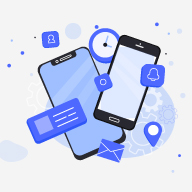5 mistakes to avoid while creating your mobile app

Digital & Technology
286 week ago — 8 min read
Background: Increasingly businesses and services are using mobile apps to engage with customers and to create a sticky solution. But for every mobile app that catches the imagination of its audience, there are several that fail to make an impression. Listed here are some common pitfalls to avoid while creating an app.
Developing a mobile application is a big undertaking. Moreover, marketing that app involves even better planning. A mobile app is a powerful way to connect with the customer base regularly. This makes it quite a personal medium, so developers and marketers need to avoid pitfalls at all costs. It is vital to ensure that the app can engage its audience.
An app becomes successful not only by its outstanding features, it needs to be marketed with the same enthusiasm. It is easy to get carried away by the opportunities that lie in the dynamic app market. Hence, there should be a balance between allocating resources, development and marketing. Unique user experience is as essential as the efforts to be put in marketing it.
A mobile app is a powerful way to connect with the customer base regularly. This makes it quite a personal medium, so developers and marketers need to avoid pitfalls at all costs.
A well-marketed app can build a brand, solidify customer relationships and its position in the marketplace. However, there are some very common mistakes marketers and developers must avoid. Being aware of these possible mistakes can help brands in eliminating them beforehand.
1. Treating mobile and desktop experiences the same
A desktop site and a mobile app should be treated as two different entities. Often, a brand’s mobile app just looks like a desktop site with tweaked resolutions and shrunk to fit. However, an app offers myriad opportunities ready to be deployed. The app becomes messier if it has the same functions as the desktop site. That’s because its difficult to input large information on apps. Hence, the app designs must be developed keeping that in mind.
Additionally, applications must be developed considering that users might not have a working or high-speed internet connection all the time. An application can hang if there is an attempt to make an API call. Users might not be aware that when an application hangs in such situations, it means that it is checking for network resources. Hence, there must be an asynchronous design, capable of performing background processes. It enables users to interact with the app and avoids the 'application not responding' pop-up.
Also read: Error 404: Mistakes you hadn’t found
2. Launching an app as a mobile site
If you are publishing an app that is just a mobile site launcher – it’s a grave mistake. Customers might soon switch to a native app that offers convenience. Developing a native app for more than one platform can be a difficult process. However, a web-based app is considered to be the wrong way. If you want to develop an app on every platform, start with focusing on one first. Get to know the customer base and take its full advantage.
After that, you can easily create multi-platform apps by employing a programming language that supports different platforms. Some of these cross-platform languages include Xamarin, PhoneGap, and Appcelerator. Also, Flutter is the latest language launched that lets you write apps on different platforms with a single code base.
3. Not interacting with the customer base
Customer retention is one of the biggest problems for app developers. Statistics say that 90% of the people leave the app in the first six months after downloading. It is important to understand that users would only come back to the app if it is offering them any value. Hence, knowing your customer base can provide you with new ways to keep in touch with them. Developers and marketers can help in generating exclusive mobile-only contests and discounts. They can add frequent updates, notifying the customers through descriptions and in the app drawers too.
Once launched, an app needs to be kept personalised for the long-term. Customers should always be able to communicate with the brand and vice-versa. An app is a great way to get engaged with customers and keep improving the performance. Feedback can be received by creating two-way communication channels. In-app communication in the form of reviews, ratings, and feedback makes it easier to give feedback and register complaints. It can also be received through intelligent prompts. All these combine to eventually increase ROI 9return on investment).
4. An imbalance between design and functions
Often an app is launched without ensuring its scalability. This leads to the app facing many bugs and issues as it runs. Hence, a database and server that is scalable should always be taken into account. Additionally, app designs should be developed according to the convenience of customers. While it is a judicious decision to implement innovative features, there should be a balance between convenience and innovation. App clarity, transparency, recognisable fields, and a design flow must be according to the customers’ needs.
In addition, the introduction of new features must be done gradually, thereby giving time to users to adapt to it. Their feedback plays a significant role in improving the features in the next update. The software must be designed in a way that is capable of running on any speed, screen or resolution. A responsive application shouldn’t consume a lot of phone battery, run too many background processes, use data, storage and network.
Also read: User Experience (UX): The bridge to digital transformation
5. Ignoring important analytics and MVP testing
Analytics is an integral part of any digital interface. They help in providing valuable customer and app insights, app behaviour, and enhance experiences. Often developers don’t utilize the power of metrics like Daily Active Users, Average Sessions, Retention Rate, App Crashes, etc. Apart from that, a smooth and error-free performance must always be a top concern. And that’s why it is essential to run an app through all types of testing procedures.
It is always better to get the app assessed through third-party and impartial users.
For this, creating a Minimum Viable Product (MVP) can prove to be a great solution. MVP means creating only necessary features for the launch before implementing advanced features. provides an opportunity to test an app in the real market. There would be daily users for evaluating the app performance. It reduces the development cost and gives an idea to improvise it further for the final product.
In conclusion
Developing an app depends a lot on narrowing down a specific base of the target audience. Planning the launch must be based on that customer base. Mistakes can happen even if it is your fourth app or the first one. What’s important is to take lessons from these mistakes and strive to do better every time. Developing and marketing an app from the user’s perspective can help in removing minute errors.
At 9series, our mobile app development strategies are always about keeping your customers engaged and building a strong brand that customers can trust.
Also read: How to build a strong bias for digital transformation
Image source: freepik.com
To explore business opportunities, link with me by clicking on the 'Invite' button on my eBiz Card.
Disclaimer: The views and opinions expressed in this article are those of the author and do not necessarily reflect the views, official policy or position of GlobalLinker.
Posted by
Nineseries Solutions9series is a well known software and mobile app development company serving clients globally.
Network with SMEs mentioned in this article
View Nineseries 's profile
SME Inspirations
Other articles written by Nineseries Solutions
Most read this week
Trending
Ecommerce 1 week ago













Comments (1)
Please login or Register to join the discussion